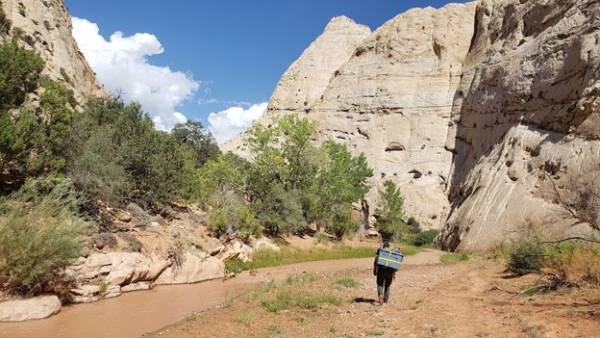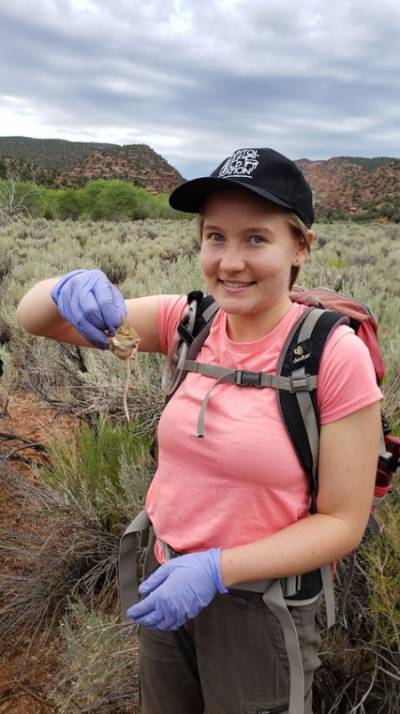CRFS welcomes both UVU and non-UVU researchers. We encourage a variety of research and creative work linked to the Colorado Plateau. CRFS helps support relevant projects by UVU researchers through our competitive grants program funded by our endowment, the Bill J. and Margaret M. Pope Colorado Plateau Field Institute Fund.
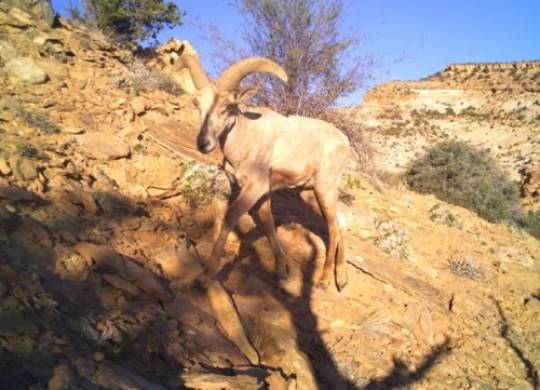
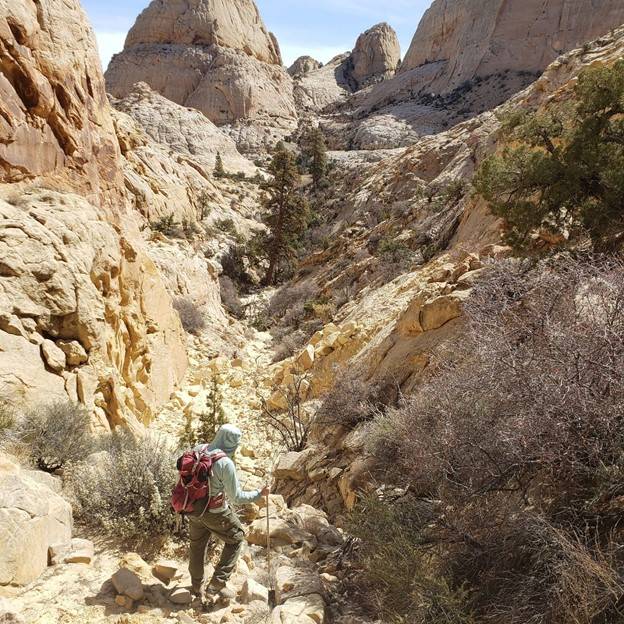
Joe Ceradini (CRFS and Biology, UVU), Dr. Eric Domyan (Biology/ Biotechnology, UVU), Dr. Justin White (Geosciences, United States Air Force Academy, formerly UVU), William Sloan (Biologist, NPS), Dr. Morgan Wehtje (Biologist, NPS), and Sandy Borthwick (Biologist, NPS, retired) received a CRFS grant, as well as additional NPS funds, to study desert bighorn sheep in Capitol Reef National Park. Joe describes the project:
“CRFS, UVU, and the NPS are collaborating to better understand desert bighorn sheep (Ovis canadensis nelsoni) distribution and habitat use in Capitol Reef National Park, which will inform management of this sensitive species. The research is based on motion-sensor cameras and genetic analysis of scat, which are non-invasive survey techniques that enable us to estimate the probability of sheep being present in different locations and using different habitats in the park. Five UVU students and one U.S. Air Force Academy student are also involved in the project. Dr. Eric Domyan’s students are conducting genetic lab work to identify the species for each scat sample and potentially estimate other genetic metrics such as diversity and relatedness between individuals. Dr. Justin White’s student is helping to manage the vast number of photos (around 1.5 million!) and will be working with Microsoft’s Artificial Intelligence for Earth to categorize images prior to analysis.
“Desert bighorn sheep populations declined sharply throughout the West from the late 1800s to mid-1900s mainly due to competition and disease transmission from domestic livestock, habitat loss, and unregulated hunting. Desert bighorn were extirpated (locally extinct) from Capitol Reef National Park by the 1940s, and disappeared from most of their range by the 1960s
“Desert bighorn were reintroduced to Capitol Reef National Park in the 1980s and 1990s from a persistent source population in Canyonlands National Park. While reintroductions in Capitol Reef and throughout the West have largely been successful, desert bighorn still face many threats, especially disease transmission from domestic livestock, habitat loss from development, and, more recently, disturbance from recreation. Within this complicated and fascinating context, continued research and monitoring are essential for detecting population and distribution changes over time, and for ensuring the persistence of this iconic species.”
UVU faculty Dr. Maria Blevins (Communication), Dr. Meaghan McKasy (Communication), Dr. Leandra Hernandez (Communication), Dr. Michael Stevens (Biology), Scott Williams (Exercise Science & Outdoor Recreation), Dr. Betsy Lindley (Exercise Science & Outdoor Recreation), and Dr. Hilary Hungerford (Earth Science) are studying the motivations and demographics of Capitol Reef National Park visitors. Maria describes the research:
“In 2012, Utah launched the ‘Mighty Five’ tourism campaign in which the state of Utah advertised the wonders of its five national parks. It was a success, park visits increased from 6.3 million visitors in 2014 to 10 million in 2016 (Sundeen, 2020). Capitol Reef has not been immune to this growth. Historically, Capitol Reef has been one of the least-visited national parks of Utah’s ‘Mighty Five,’ but is now dealing with issues related to exponential growth in tourist numbers. The increase in visitor numbers affects how personnel manage trails and other resources as well as the experience visitors have while in the park.
“Employees at Capitol Reef National Park have expressed a need and desire to conduct social science research on the visitors coming to the park. This study aims to understand which factors have produced this astounding increase in visitation, specifically visitor motivations for visiting Capitol Reef National Park, as well as the type of experience they are seeking. A Capitol Reef social science team has been created to collaborate with the park; this team of interdisciplinary researchers represents the fields of Outdoor Recreation Management, Biology, Geography, and Communication. The project has been supported by a Presidential Research Fellowship and a grant from Capitol Reef Field Station.
“With the help of two classes (COMM 3115 and REC 4400), two student research assistants (Madison Anderson and Erin Kratzer), professors, and volunteers, this team has collected data over the course of 11 days during the spring and summer of 2021. A total of 685 short surveys and 145 longer surveys, which were sent in an email two weeks after initial contact, were collected. Additionally, qualitative data in the form of observation and informal interviews were collected. The research team will be meeting throughout the fall to provide a full report to the staff at Capitol Reef. This project is a beautiful example of engaged and applied scholarship.”
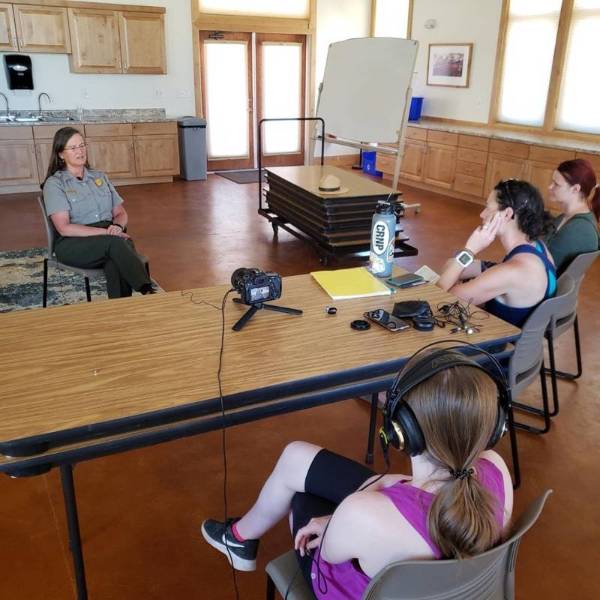
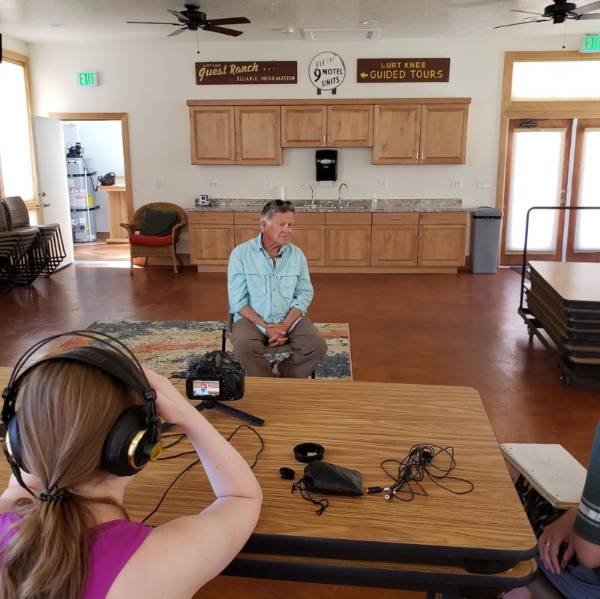
UVU faculty Emily Hedrick (Digital Media), Amber Smith-Johnson (English & Literature), and Joel Bradford (Earth Science) received an NPS grant to digitally preserve the cultural history of Sleeping Rainbow Ranch in Pleasant Creek Valley, Capitol Reef National Park. This project included interviewing Chip Ward, a local author, and Park Superintendent Sue Fritzke. Amber describes the context and goals of the project:
“Capitol Reef National Park provides not only a stunning and dramatic backdrop of the American West; it also offers a unique glimpse into the intersections of cultures, peoples, and land uses that overlap one another in remarkable ways. One particularly rich story is of the Sleeping Rainbow Ranch, nestled between Capitol Reef Field Station and Pleasant Creek. While the hotel and homes associated with the ranch are long gone—the field station actually sits on the footprint where those buildings once were—the fences and outbuildings of the ranch can still be seen along the valley floor. Interestingly, though the ranch remains as a piece of Capitol Reef National Park history, there has been a current lack of educational material dedicated to it. Because of this gap in public knowledge regarding the Sleeping Rainbow Ranch, UVU faculty and students wanted to fill in the underrepresented narrative.
“Faculty members Emily Hedrick, Amber Smith-Johnson, and Joel Bradford assembled a team of students from Digital Media, English, and Earth Science to help bring the Sleeping Rainbow Ranch story to light. The team was awarded the NPS Preservation Technology and Training Grant, which allowed them to create a sort of virtual field trip with immersive tools such as 3-D augmented and virtual reality (VR) and photogrammetry. The team conducted interviews to help create a short documentary piece that will inform the viewers of the ranch’s history and its unique place in the national park. They also created a printed pamphlet for the visitor center. The pamphlet will be an attractive addition to the educational materials the park can offer for visitors and will feature fun, interactive elements as well. Included in the pamphlet’s historical facts and timelines will be augmented reality (AR) features that guests will be able to scan with their smartphones. Once scanned, guests can access even more information, including 3-D images, fun facts, and ranch history.
“Ultimately, however, the UVU team and NPS are hoping to share these videos and images with virtual visitors outside of the park as well. By making these assets available to K-12 and post-secondary education sites throughout Utah, viewers will be able to virtually walk the paths around the site as though they were on the dusty Pleasant Creek Road themselves. Viewers will also be able to virtually enter the buildings that still stand on the property and investigate the old walls of the outbuildings and rough-hewn fences. By using such newlyemerging, engaging technology, UVU and the NPS are hoping that together, a wider range of park visitors will be able to enjoy this piece of the past.”
Joe Ceradini (CRFS and Biology) received a UVU Engaged Learning grant and a CRFS grant to study small mammals in the park. Joe summarizes the research:
“In Capitol Reef National Park, and throughout canyon country, the Mexican spotted owl (Strix occidentalis lucida) primarily eats herbivorous and granivorous small mammals, such as woodrats (Neotoma spp.). So, factors that affect small mammals can also impact Mexican spotted owls. For example, through the alteration of plant communities, livestock trailing has been shown to influence small mammals, in some cases reducing small mammal diversity and abundance, which in turn could influence Mexican spotted owls. It is therefore important to assess the quality of Mexican spotted owl foraging habitat when livestock trailing is present.
“I worked with two UVU biology students, Hayden Kerr and Alisa Baadsgaard, to study small mammals within the Oak Creek and Pleasant Creek valleys in Capitol Reef National Park. The two valleys have similar ecology, hydrology, and geology in many respects, but cattle use is substantially higher in Oak Creek than in Pleasant Creek. This variation enabled a comparison of small mammals within riparian and upland habitats between valleys that differed in cattle use and disturbance. Results will inform park management decisions, such as management of cattle trailing within potential Mexican spotted owl foraging habitat.”
